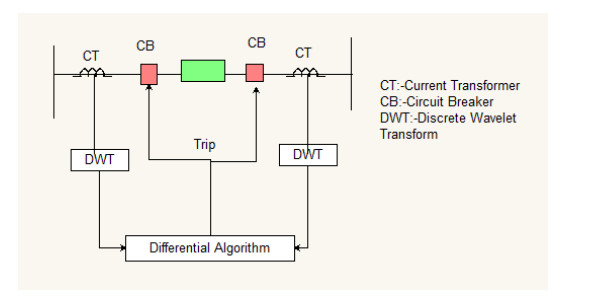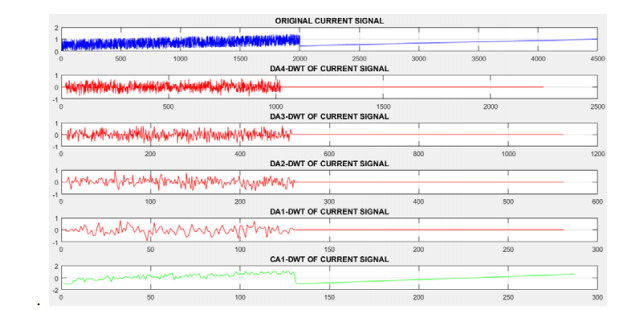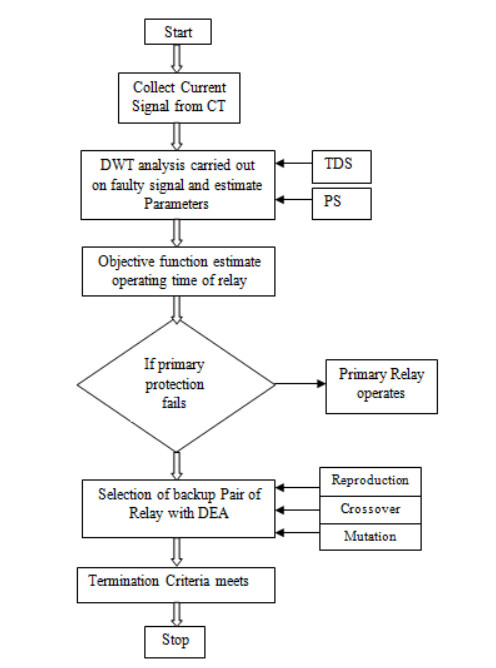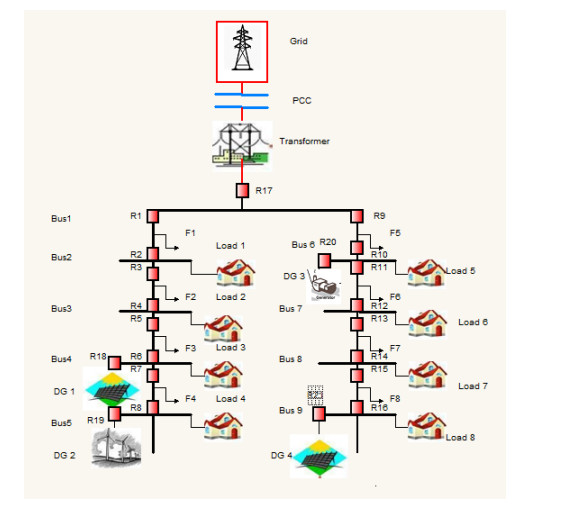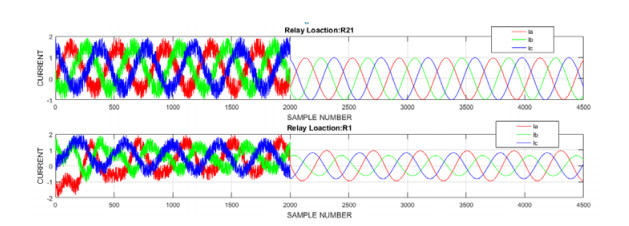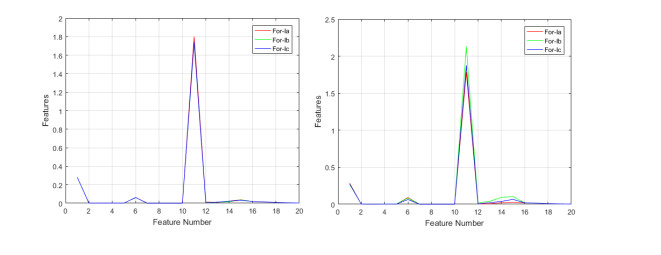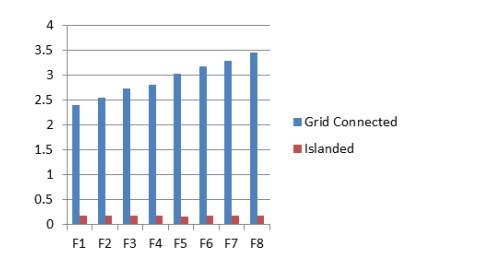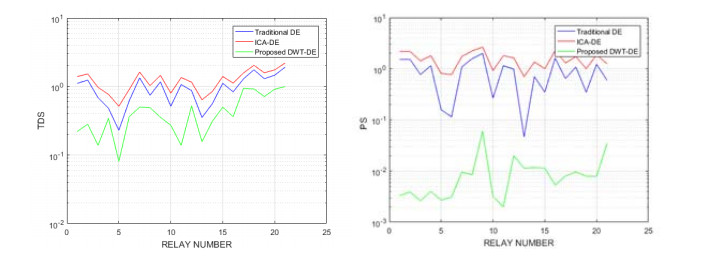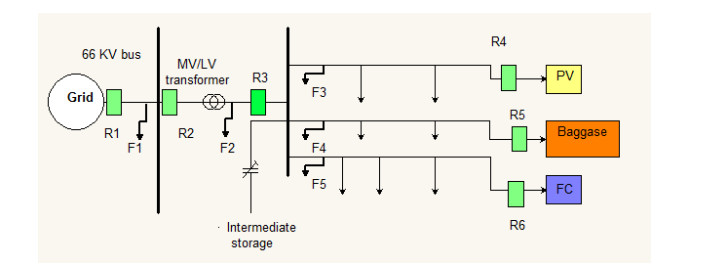The microgrid is assuming an indispensable role in the power area and greatly affects inexhaustible reconciliation. There are numerous specialized troubles to move so as to utilize high ability in the microgrid. The significant issue in the microgrid has its protection challenges as the bidirectional progression of current moves through transports. This paper proposes novel Discrete Wavelet Transform-Differential Algorithm Techniques, which help to secure Distributed Generations and other costly electronic parts from the defective condition. The occurrence of any shortcoming on the microgrid causes alters in amplitude and course, which prompts a hamper on the surviving protection framework. In the proposed scheme, short circuit current is pre-processed through discrete wavelet transform (DWT) transform to remove all noise and high pass and low pass content in the signal and undergoes state-of-art of adaptive protection for selection of relay. This algorithm implements on the Standard IEEE 9 bus system in MATLAB environment and with a single line to ground fault at 8 locations tested with pair of 21 relays for primary and backup protection in the grid-connected and separated mode of operation. The traditional methods compared with the proposed method in terms of Different parameters like PS (plug setting ), TDS (time dial span), CTD (coordination time duration), Top (operating time of relay). To prove the better implementation of results, one real-time system as a case study selected with the hybrid microgrid.
1.
Introduction
Microgrids have been expanding areas for instance, improved beneficial structure, diminished monetary costs, better force quality, and created system dependability [1]. The Cluster of circulated generators with a load having its protection, correspondence framework called as ‘Microgrid’. Insertion of distributed generators (DGs) through the microgrid provides the solution for the greenhouse effect as well as global warming; on the other hand leads to many challenges like DG integration, Islanded mode of operation changes behavior of the current, protection issue is much concerned [2].
The two kinds of actions are grid-related way and disengaged way for the microgrid. In grid associated way, all loads in microgrid boost power from the utility and small scale energy resources. In the network, disengaged mode power gain by all loads from generation resources and with the help of load shedding control balance will maintain.
Despite different favorable circumstances of the Microgrid with DG arrangement such as solar-wind, solar-diesel remembering the ability to work for islanded mode, the protection challenges transform into an authentic concern, where the execution of the conventional relay diminishes the reliability quality and stop to work [3]. The Direction and amplitude of fault current changes as per the addition of DGs take place. Inverter based DGs contribute bidirectional current while DFIG (doubly fed induction generator) can help 5 to 9 times more current than usual DGS [4]. Due to non-promising behavior of DGs in the microgrid relays connected at end to end must be explicit and reliable [5]. Control and protection are significant issues related to the microgrid. In this manner, the traditional overcurrent relay with a specific setting, utilized for microgrid protection, does not give precise and dependable protection measures considering both mesh and radial activity of the microgrid [6].
In [7], propose line voltage obtained in terms of Va Vb Vc from DGs converted to DQ frame, and afterward, divergence and then the deviations of these values from reference values computed. Difference estimated from variables stated command relay to operate. A communication link provided between relays. (Voltage based protection schemes). The second author studied [8] by dividing the microgrid network into different groups relay communicate with the asynchronous link. The wavelet transforms in time domain used for fault location. As the judgment of results made in a distributed manner central processing unit (CPU) not required. One primary requirement with this technique is the high-speed web of communication is mandatory; other microgrid control techniques have suggested that it depend on a communication strategy [9].
The method [19] proposed in this paper tackles the meshed distribution system in the existence of synchronous DG; the same approach will not apply to converter based DG. The paper [17] gives the necessity of relay to operate in both directions. This research recommends the double set of the relay but fails to convince the same technique for meshed like the structure of the microgrid [20,21]. Different techniques for protection proposed, but there are limitations on time [22]. The data mining method is not effective as it requires more significant no of training for data to get the desired output [23]. Grid-associated, as well as the Grid-separated mode, is suggested but need to change relay setting for change in method of operation [24]. Relay coordination based on microprocessor relay recommended, it took more time, hardware setup increases and proposed only for low voltage [25]. Protection with communication assisted relay offered, but the scheme becomes more complicated. The researcher studied more on the optimization method, as it will conclude to final output in lesser time. The genetic algorithm is the optimization method used in [27,28] with overcurrent relays. The main drawback noticed there is no synchronization between primary and secondary relays. CTD value has a cross limit, and the secondary relay operates before the central relay, which leads to loss of coordination. The author [29] suggests new technique of protection, analysis of dq signal in fault detection and wavelet transformation for eliminating unwanted frequency signal is studied.
The DWT-Differential algorithm technique is unable to detect fault in single-ended microgrid however DWT based designed digital relay defiantly helps in decaying operating time and growing reliability of the system. The optimization technique is more effective when synchronization of relays is carried out in multigrid.
Objective of this study is protection of microgrid to guarantee secure operation
1) Deals with both connected and disconnected modes.
2) Developed optimized protection scheme with relay coordination.
3) Minimizes operating time of the relay.
4) Real time hybrid microgrid is studied.
The rest of article is organized as follow section 2 deals with invention of mathematical expression for optimal programming and dual setting parameter Section 3 deals with. Methodology with validation section 4 gives details of result and discussion section 5 gives real time implementation case study.
2.
Mathematical expression for optimal programming and dual setting parameters
2.1. Mathematical expression
An optimized relay coordination function limits the total functioning period of relay and wipes out the disharmony between principal and secondary relays. An evolution issue categorizes the main objective is to confine the standard relay working time. In the microgrid, the ideal coordination with directional overcurrent relay (DOCR) results in settling both grid-connected and disconnected methods of activity.
The operational period of the regular DOCR is conversely varied with the shortcoming current (Isc). Two main parameters that mainly affect operating time are (TDS: Time Dial Span) and (PS: plug setting) as given underneath in condition (1) Plug setting characterized as the fraction of Current from device to reference current or pick up current [11,12].
where F(tij) is the working period of the relay, i is the relay identifier, and j is the location where the fault occurs. The constant values 0.14 And 0.02 expressed in Eq (1) are obtained from time-current characteristics of IDMT relays [17].
The primary Objective function, as mentioned in Eq (2) whose value has to minimize, can be defined as the summation of operating time of the elementary (primary) and secondary (backup) relay
In the above equation, P indicates connection mode, either grid-connected or separated way, P is varying between digit 1 and 2. One is assigned for grids connected while two for the grid separation mode. Q is the number of total relays used. R is the full positions of occurrence of faults. tprfw_cij is the initial relay’s working time for ith relay, in the leading direction, for short circuit occur at a location at j. tbkrv_cij is the backup relay’s working time for ith relay, in the counter direction, for fault location at j, k in backup relays denotes total number of secondary (backup) relay used. Forward and reverse equation for working time of the primary and the secondary relay is expressed as Eqs (3) and (4)
The coordination condition ought to be satisfied while taking care of the optimization issue, which is, least difference in working span amongst the principal and secondary (backup) relay, recognized as the coordination time duration (CTD), as a notice in condition (5) must maintain [11,12]. For each shortcoming area, there might be more than one backup relay, so some relay needs to fulfill a few restrictions. In this way following requirement is characterized
Value for CTD usually defined as 0.25, which is builds upon the manufacturer [12]. For satisfactory result and avoiding disharmony among the relays upper and inferior limit of PS and TDS is specified in (6), (7), (8), (9). PSi_min And PSi_max are upper and lower limit of relay plug setting for number i, which depends on the current flowing through the load. TDSi_min And TDSi_max are upper and inferior limit for time dial span for i relay, which depends on the producer.
2.2. Dual setting parameters of relay
Time dial span (TDS) and plug setting (PS), which further depends on pick up current, are essential attributes that have to optimize within the specific limit so that ultimately the operating time of the relay will get reduce. On the other hand, these parameters decide the operating characteristics of dual setting overcurrent relay [18]. The unidirectional overcurrent relays operate in the forward direction. In contrast, double setting relays can design with forward and reverse settings each designated for a particular fault magnitude and direction (Refer to Figure 1).When current flows in the forwarding direction, TDSfs and Ipfs are settings for primary relay and when current flows in the reverse direction TDSrv, and Iprv are settings for the backup relay. The value in the proposed research ability of the dual setting relay to operate in both directions is fully utilized.
When fault take place on the feeder voltage level decreases to great extend DGs which are specially inverter interfaced output current decreases and flow in opposite direction [30]. The unidirectional conventional protection system fails in this case however bidirectional working relay protection scheme proposed operates efficiently. The setting of Relay is adjusted to operate in both directions.
3.
Methodology with validation
3.1. Proposed method of discrete wavelet transform—Differential Algorithm
The proposed method is extended version of optimized algorithm projected by author in [15]. The additional work discovered in this research paper is DWT based differential evolution algorithm used, which leads to higher accuracy in relay coordination in grid-associated as well as a grid-separated mode of operation. When the fault occurs on the system, the current is supplied to the DWT analysis block directly through CT. In the grid-associated way rate of a short circuit, the current is more as compared to Islanded mode.
The sinusoidal waveform of fault current contains excessive unwanted information, which takes more time to detect the location of the failure. Hence to decrease the working time of relay, DWT analysis first carried out on a short circuit signal. Fault or no-fault condition detected with the help of DWT. when failure reaches a particular point. Secondary of CT pass signal to DWT block and most appropriate assessment for value TDS and PS will be fetched out by captivating short circuit current as input. Objective function estimates the operating time of the relay. In the overall process, the central pair of the relay first selected and removed the defective bus. On failure of prime protection, a backup pair of relays chosen with the help of the Differential Algorithm. Figure 2 explains the working of the proposed system.
There are many techniques used in extracting data from the signal. Fourier transform uses extensively in the decomposition of the waveform, but the main issue with Fourier is the domain area provides magnitude and time. Wavelet transform designed by the researcher to overcome this issue. The favorable primary position of Wavelet Transform over Fourier Transform technique is that the depth of examination window fluctuates for the recurrence investigation at which Wavelet Transform can offer a superior trade-off as far as confinement. The signal can be decomposed with a continuous and distinct wavelet transform. The distinct Wavelet Transform is more straightforward to execute than a Continuous Wavelet transform. This technique is figured by changing the size of the examination window and moving the window in time or duplicating the signal, and the data of absorption is regularly a mix of highlights that are generally fast.
Where, f is a time-domain signal, F is the transformed signal in the frequency domain, Eq (10) is for the WT, where f[T] is the target signal, W[T] is the chosen Wavelet and α, and β are the scaling and shifting variables, respectively
The Proposed research pre-processes short circuit current signal through DWT to extract the most significant feature to detect the location of the fault and to remove all noise factors from the signal, which ultimately helps to reduce the time of the operating relay [12]. The fault current if experiments with frequency 6.5 Khz, the reference voltage value recycled is 20 MVA and 480 V for per entity implementation. There are four detailed coefficients (DA1-DA4) obtained after analyzing the signal as shown in Figure 3
Differential evolution algorithms first discovered by Storn and Price [13]. To understand the probability-based methodology of determination of the best pair of relay for secondary protection, ‘Endurance of fittest’ is one of the developmental methods for improving technique utilized. It begins with the search for the irregular arrangement of populaces, and settlement with better wellness is chosen as a parent to create people to come.
As can be seen in the flow chart, Figure 4, stepwise DWT-Differential Evolution Algorithm is described. The most significant essential factors responsible for the Endurance of fittest are TDS and PS. At the termination of iteration new calculated value of TDS and PS is fed to the algorithm till end criteria satisfied. The process of optimization starts with no of randomly selected chromosomes; each chromosome has floating no here that is no of relays 21. Initially, 1000 populations generated with a lower and upper bound of constraint. The differential algorithm mainly works on three stages that are as follows.
● Reproduction: determination of coordinating pair, the chromosome with better wellness chosen for mating, and more prominent opportunity to endure and repeat.
● Crossover: execute to create new chromosomes called posterity. Where two chromosomes trade some portion of data to deliver a new chromosome.
● Mutation: It is acted in every cycle to keep calculation from area least trap, this procedure will proceed till it spans to end criteria.
In an arranged vector set get with steps according to the flowchart, if the maximum count is reached then vector results in optimizing the value of working time of the operating relay. After the algorithm steps computations, the value of Xbest is attained, and the further process terminated. At that point, if tally does not match with criteria, then, for new iterations incremented by one and count repeats.
3.2. Analysis and study of proposed algorithm on IEEE 9 bus system
3.2.1. Standard IEEE 9 bus system description
The general utility is converted to microgrid by connecting different DG sources to the typical IEEE 9 bus system. The crossbreed microgrid is created by involving various distributed resources such as PV cell, wind, and diesel [15] representation of the new microgrid is aligned in Figure 5. The transmission line through the transformer is fed up with two parallel feeders with nine buses. L1 to L8 are load connected while R1 to R21 are relays connected to each feeder.DG1 and DG4 are solar generations, while DG2 is wind combined, and DG3 is the diesel generator. From PCC, two 11 Kv buses are separated with an impedance of 0.1528 + i0.1407 ohm per kilometer. The Length of the total feeder is 1000m long, each having the same length. The inductance to resistance ratio varied from 0 to 6. The 20 MVA transformer is connected at the utility side to step down voltage from 115 kV to 12.47. The distributed energy resources have rating 480 V, 20 MVA inductance ratio is 0.11. Solar, wind, and diesel generator are used with transformer rating 20 MVA, 115Kv/12.47KV. The load is distributed in domestic, commercial as 2 MVA with power factor 0.9.
3.2.2. Relay Setting Calculation in terms of TDS and PS
For the dual setting of the relay, Parameters are TDSfw, Psfw, and TDSrv, Psrv, which is selected optimally. The new proposed scheme makes coordination work satisfactorily. In the traditional method of protection [15], primary and backup relay require the same setting characteristics for fault occur on the system. Then again, for the suggested order, every relay armed with forward and reverse symptoms, so each has to satisfy either primary or backup function. It will become more comfortable for the algorithm to select relay, and the operating time of the relay will automatically get reduced. Table 1 shows all the optimized value of TDS and PS
3.2.3. DWT calculation of Short Circuit Current
DWT is the best tool for removing all extra unwanted information from the Current Signal. Short circuit current signal (Iabc) coming from secondary of CT disintegrated into a fraction of four coefficients. The decomposition of the signal takes place with Daubechies Wavelet (db4) up to 4 levels. For sample calculations, only two fault locations 21 and 1 are tested with DWT. Figure 6 demonstrates DWT extracted current versus sample number; DWT designed naturally modifies window width to give a great time decision.
DWT carried out on the signal gives the essence of fault current by removing noise. In paper [15] short circuit current ISC is feeding directly to the optimization algorithm, which contains noise and high pass and low pass content in the waveform, which increases the operating time of the relay. Figure 7 shows Ia, Ib & Ic fault current waveform at position R21 and R1 with DWT extracted features.
When the analysis is performed on values obtained in Table 3, it is clear that for location f1, relay one and two acts as a primary relay in the first zone while relay ten, seventeen, and four acts as secondary in the same protection zone. SLG (one phase to ground) fault is generated on the system by the captivating value of resistance one ohm in MATLAB, When the error occurs on location f2, R3 and R4 act as a primary relay. At the same time, R1 which is the primary relay for f1 action as a backup for f2.In this way, subject to the position of the fault priority of relay changes. After DWT analysis carried out, symmetrical and non-symmetrical faults at eight different locations analyzed. On the other way the DG network can disconnect from the utility with the help of a circuit breaker at PCC (point of coupling), R17 relay will get out as it connected between the service and the microgrid. All fault current at eight different locations again noted in islanded mode by emitting R17. The Figure 8 clears that the value of fault current in islanded mode is less than the grid-connected method as an alteration in mode stops the bidirectional flow of current.
3.3. Validation of proposed algorithm
In this section, various variable assessments carried out between the traditional method [15,16] and the proposed method. To evaluate performance more clearly Average value of PS (Plug setting), TDS (time dial span), top (Operating time), and CTD-1 (Coordinate time duration for grid-connected), CTD-2 (Coordination time duration for Islanded) given in Table 4. The traditional method and ICA-DE tested on the same system with different eight fault locations. The value of PS obtained with the conventional approach is 2 (PU), while it decreases with ICA to 1.93 (PU), and by using DWT, it becomes 1.857 (PU). Optimize changes in the value of TDS and PS effects in subsiding the working period of the primary and secondary (backup) relay. It observed that the average amount of CTD 1 is 0.2513, and CTD 2 is 0.27349; all the CTD values are equivalent to or superior to 0.25 second. From the Table 6 given in the Appendix, it is clear that the backup relay operates after the primary relay fails. The amount of CTD will indicate that all designed relay settings are working accurately.
TDS and PS plotted against the location of the relay are aligned to exhibit the presence of the proposed technique in Figure 9. It discovered that DWT-DE reliably surpasses the conventional strategy under all test frameworks and designs. It very well may be seen that DWT-DE joins to a superior arrangement in a quicker time, a potential clarification for that is DWT evacuates the issue of frame width examination. The value of PS is optimized, ultimately working period of overall system boosted. Figure 10 gives a comparative analysis of operating time among the traditional and proposed methods. The chart representation of running time with PR (old), PR (ICA-DE), PR (Pro) indicates primary relay running time. Where term PR represents old (overcurrent relay method) ICA-DE (independent component Analysis differential evolution) pro (proposed method of the discrete wavelet transform differential algorithm) for primary relay and BU indicates backup relay running time.
4.
Projected algorithm implementation: Case study
In Maharashtra, many remote areas are facing the problem of shortage of power. Microgrids typically designed to provide electricity to small, rural, individual units. These often developed by the non-government community. For hamlet Wani in Maharashtra located at district Yawatmal above model is proposed by Green Energy Ltd Chanaka and Rasoya power ltd, [26]. Centralized grid connectivity is 33 kv/66 kv bus. 500 kW solar plant is located at village Maregaon 2 km away, 10 Mw Baggase plant located at community Raju 10 Km away from the grid. The 3.5 mW fixed capacitor DC sources 20 Km are connected to the network. Fault location DG line diagram aligned in Figure [11].
In present traditional Overcurrent Relays are used for protection of a single bus. Due to the fixed setting installed circuit breaker and relays take 0.3 cycle for clearance of fault due to lower short circuit current level contributed by DGs used in the network. Therefore it is mandatory to redesign to short circuit current protection scheme into the new protection scheme fulfilling following changes (ⅰ) Decrease operating time of Relay (ⅱ) speedy response on the occurrence of a fault (ⅲ) Detecting fault in respective of short circuit magnitude (ⅳ) increase reliability and accuracy of the system. To overcome all issues in the traditional protection system, a novel optimized protection system with the DWT-differential algorithm suggested.
Table 5 gives results of Actual fault clearance time with traditional method and proposed method; it suggests that the DWT-Differential algorithm designed relay takes less time to mitigate fault at a different location. Figure [12] gives clearance of time at location f1.
5.
Conclusions
The capricious conduct of microgrid causes different difficulties in the assurance of microgrid. To guarantee the security and reliability of the microgrid framework proposed versatile protection is the best arrangement.
The proposed method of a Dual-adjustment DWT-DA is specially designed for a smaller distributed network. The Successful Algorithm minimizes the value of PS and TDS, which ultimately optimized the operating time of Relay. Typical IEEE 9 bus system tested with 21 pairs of the relay by creating eight faults at a different location. A comparison is made between the traditional method and the proposed method with different parametric matrices to give better efficient results.
The MATLAB waveforms obtained clear that the suggested methodology is talented in allocating various fault situations and optimized relay coordination. On-site application contextual analysis recommended with Actual fault clearance time with the traditional method. The excellent execution of the proposed technique is a consequence of the novel way in which the protection of the Microgrid carries out with reliability and accuracy. Future work will focus on creating different faults, including HIF, on a different system and tested with the proposed algorithm.
Conflicts of interest
The authors declare no conflict of interest.
Appendix
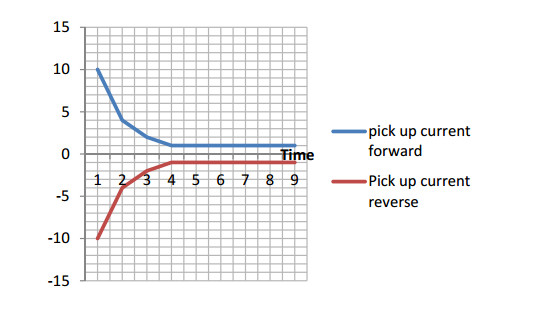









 DownLoad:
DownLoad:
